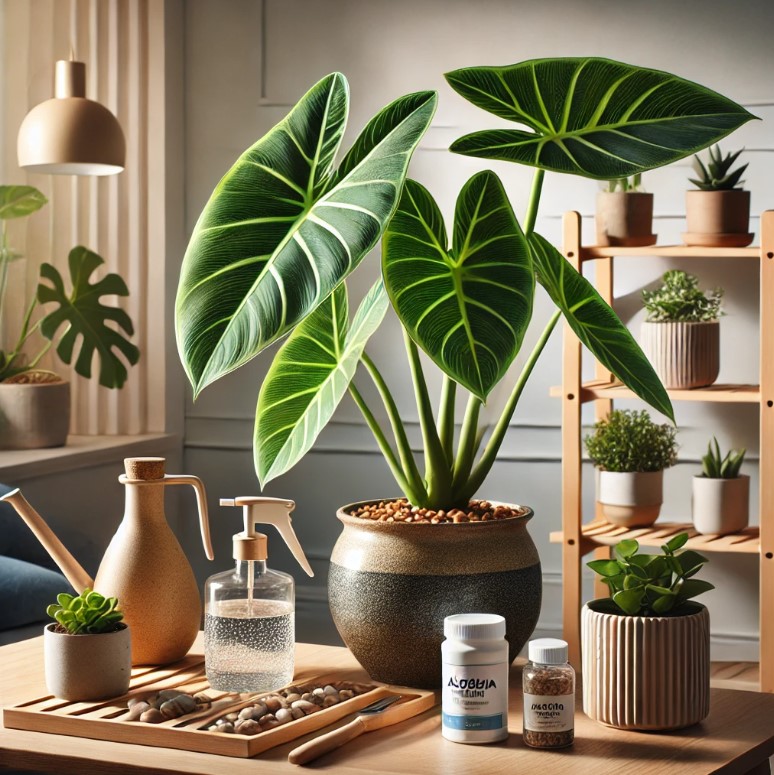
Alocasia Regal Shields are a tropical delight with their beautiful foliage and part of the beloved Alocasia plant family. While these amazing plants can help to turn any indoor space into a green paradise, they need particular care in order to survive. Keeping your Alocasia alive requires knowledge about things like humidity, how often to water, as well as many other factors that need to be considered to keep them happy. This ultimate guide contains the most important care tips to assist your Alocasia (including Regal Shields) in reaching its full potential. Whether you are a pro with plants or just someone new to being a plant owner, these tips will help provide the perfect environment for your plant.
1. How to Identify and Differentiate Between Alocasia Regal Shields and Other Types
Alocasia Regal Shields develops huge, shield-shaped leaves with a dark green top side and purple bottom side, all covered in a somewhat velvety surface. Though it will add a tropical touch like all Alocasia plants, it is also going to require somewhat diligent care.
2. Lighting Conditions for Alocasia
Alocasia will do best in a place with bright indirect light. Too much direct sunlight will burn its leaves, and too little light will slow its growth. If possible, position the plant on an eastern-facing windowsill or screen sunlight rays by using curtains.
3. How Often to Water Alocasia
Consistency: Let the top inch of soil dry out in between waterings
Method: Water thoroughly and let it drain off. Do not let them stay in water as it can cause root rot.
Water: Cut back on watering when inactive in the cooler months.
4. Balanced Soil Mixture for Good Growth
Plant it in a soil mix that is designed to drain, as this helps avoid root rot. This is the perfect mixture of a combination of potting soil, perlite as well as peat moss used to address both aeration lower water loss. To improve drainage, you can add orchid bark or sand.
5. Maintaining Humidity Levels
The ideal humidity for Alocasia is between 60 and 80%. To increase humidity:
Have a humidifier beside your plant.
Mist the leaves with distilled water frequently.
Keeping the planter next to a pebble tray with water
6. Alocasia is a tender tropical plant so it enjoys warm temperatures.
Place your plant in a steady temp room between 65-85°F (18°C to 29°C) Do not put your plant in a place where it is exposed to cold drafts and do not move it suddenly to a hot or cool shower, as this will only put the plant under stress.
7. Fertilizing Your Alocasia
During the growing season (spring, summer) fertilize with a balanced water-soluble fertiliser every 2-4 weeks. During the fall and winter months when growth slows down greatly, feeding should be reduced.
8. Cleaning and Pruning Tips
Check for dust and remove with damp cloth, (so that they breathe better!)
Pruning: Cut back on yellowing or damaged leaves to keep the appearance of the plant and improve health.
9. Repotting Your Alocasia Plant
If it outgrows its pot after 1–2 years or gets root-bound, repot your Alocasia. Use soil, and the size of a pot that is one size bigger than the existing one.
10. Managing Dormancy in Alocasia
Alocasia will sometimes slow down and not grow in the cooler months, losing leaves as it goes dormant. During this time:
Reduce watering.
Stop fertilizing.
Place the plant in a warm and humid environment
11. Top Pests And Ways To Treat Them
Alocasia plants may be susceptible to pests like spider mites, mealy bugs and greenfly. Check the leaves and stems frequently for any traces of infestation. Treat with neem oil or insecticidal soap
12. Propagation Techniques
You can propagate this plant through division. When you repot the plant, gently separate the rhizomes and plant them in new soil. Give similar care to the parent plant as possible to promote growth.
13. Common Problems to Identify and Fix
Yellow leaves: Usually due to overwatering or lack of drainage.
Browning on the Edges: Often a symptom of insufficient humidity or erratic watering.
Lack of growth is a sign that light or food may be lacking
14. Pot Selection for an Alocasia
Pot with drainage holes You would want to choose a pot that has drainage holes for water not to accumulate too much. You can use decorative pots as outer covers, but do not neglect their functionality to provide the health of the plant.
15. What Makes Alocasia Regal Shields So Popular
This cute little plant is known for its beautiful foliage, easy maintenance and the added aesthetic value it brings to our indoor spaces — Alocasia Regal Shields. This design is a popular choice with collectors and plant enthusiasts due to its striking look.
Conclusion
Alocasia plants are majestic, unique houseplants that can be very forgiving when watered correctly and one of them is Regal Shields. You can help your plant survive and thrive by understanding its individual requirements for light, water, humidity and care. And whether you’re a green bean or an old plant owner, you can follow these care tips to keep your Alocasia Give it time over the years to continue serving as a stunning centerpiece in your indoor garden.




